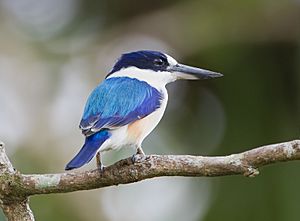Forest kingfisher facts for kids
Quick facts for kids Forest kingfisher |
|
|---|---|
 |
|
| Daintree, Queensland, Australia | |
| Conservation status | |
| Scientific classification | |
| Genus: |
Todiramphus
|
| Species: |
macleayii
|
The forest kingfisher (Todiramphus macleayii) is a beautiful bird known for its bright blue and white feathers. It is also called the Macleay's kingfisher or blue kingfisher. This bird is a type of kingfisher that lives in trees. You can find forest kingfishers in Indonesia, New Guinea, and along the coasts of eastern and northern Australia. Like other kingfishers, it loves to hunt for insects, small frogs, and lizards.
Contents
About the Forest Kingfisher's Name
The forest kingfisher was first described by two naturalists, Sir William Jardine and Prideaux John Selby, in 1830. Its scientific name, Todiramphus macleayii, honors a Scottish scientist named Alexander Macleay. He was an important person in New South Wales, Australia, a long time ago.
There are three main types, or subspecies, of the forest kingfisher:
- T. m. macleayi: This type lives in the northern parts of Australia, like the Top End.
- T. m. incinctus: This one has a slightly greener back and is a bit bigger. It lives along the east coast of Australia.
- T. m. elisabeth: This type is found in eastern New Guinea.
What Does a Forest Kingfisher Look Like?
Forest kingfishers are about 21.5–25.5 cm (8.5–10.0 in) long. Male birds usually weigh between 32–43 g (1.1–1.5 oz), and females weigh 29–44 g (1.0–1.6 oz). They have bright blue wings, head, and tail. Their chest and belly are white, and they have a white patch on the back of their neck.
Look closely, and you'll see a white spot in front of their eyes. A black stripe goes from their beak, through their eyes, and towards their ears. When they fly, you can see a white patch on their wings. Female kingfishers have a blue patch on the back of their neck instead of white. Their eyes are dark brown, and their legs and feet are dark grey. Young kingfishers are not as brightly colored and have a darker head. Their call is a sharp t-reek sound, which they often repeat in the morning.
Where Do Forest Kingfishers Live?
The forest kingfisher is native to (meaning it naturally lives in) Indonesia, Papua New Guinea, the Solomon Islands, and Australia. In Australia, you can find them near the coast from Port Stephens in New South Wales, all the way north to Cape York, and west across the Top End.
In the southern parts of Australia, like New South Wales and southern Queensland, they visit during the summer. But in other areas, they live there all year round. As their name suggests, they like to live in forests. They prefer dry forests, moist lowland forests, and mangrove forests near the coast. They also like Melaleuca swampland.
How Forest Kingfishers Behave
What They Eat
The forest kingfisher is a skilled hunter. It eats many different things, including insects like bugs, beetles, grasshoppers, spiders, and butterflies. They also hunt small fish, frogs, tadpoles, lizards, and even tiny snakes.
They usually watch for their prey from a high spot, like a tree branch. When they see something, they dive down to the ground or into the water to catch it. After catching their meal, they fly back to their perch. Sometimes, they hit their prey against a branch to kill it before eating.
How They Raise Their Young
In Australia, forest kingfishers usually breed from August to February. They often have two groups of babies during this time. Their nest is a short tunnel that leads to a round room inside a termite nest, usually about 4–12 m (13–39 ft) high in a tree.
Female kingfishers lay three to six (but usually four or five) shiny white eggs. Each egg is about 25 mm × 22 mm (0.98 in × 0.87 in) in size. Both parents work together to keep the eggs warm for 18 to 21 days. After the chicks hatch, they stay in the nest for 27 to 31 days. The parents continue to feed them for about a month after they leave the nest.
Are Forest Kingfishers Endangered?
Even though the number of forest kingfishers is slowly going down, they are not currently in danger of disappearing. Scientists classify them as a species of least concern on the IUCN Red List. This means there are still many of them around the world.
Gallery
See also
 In Spanish: Alción de Macleay para niños
In Spanish: Alción de Macleay para niños




